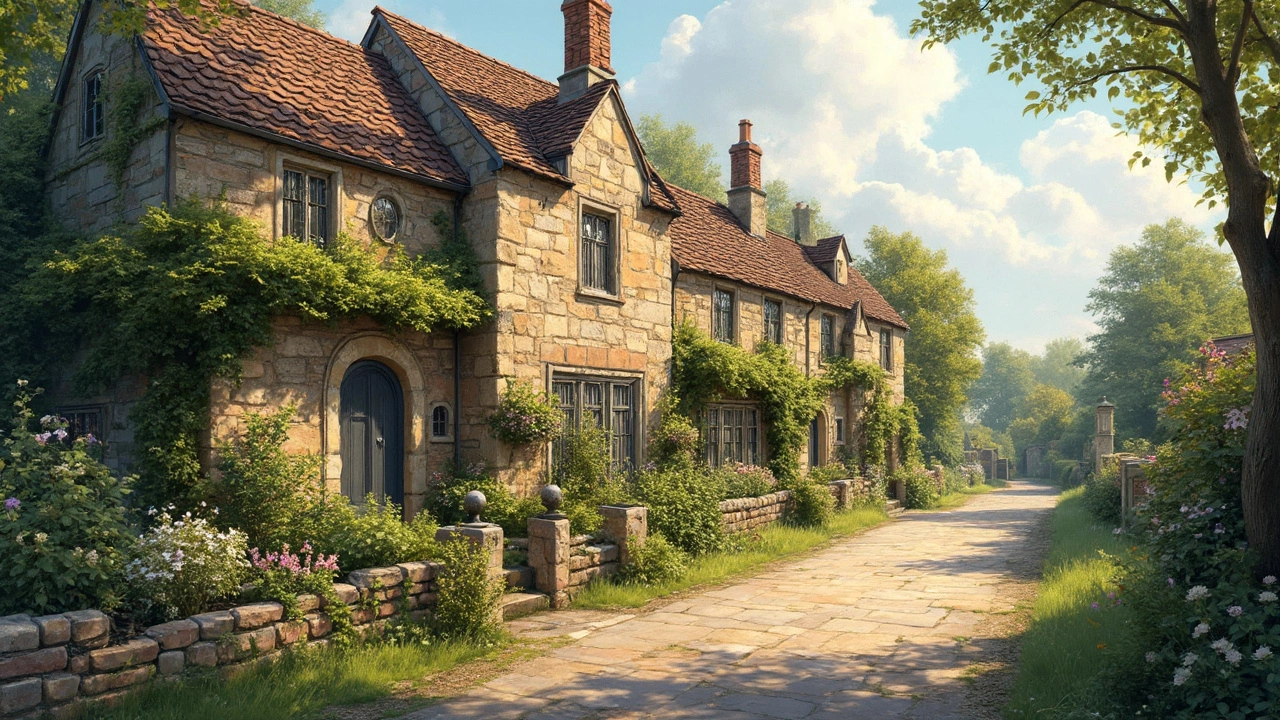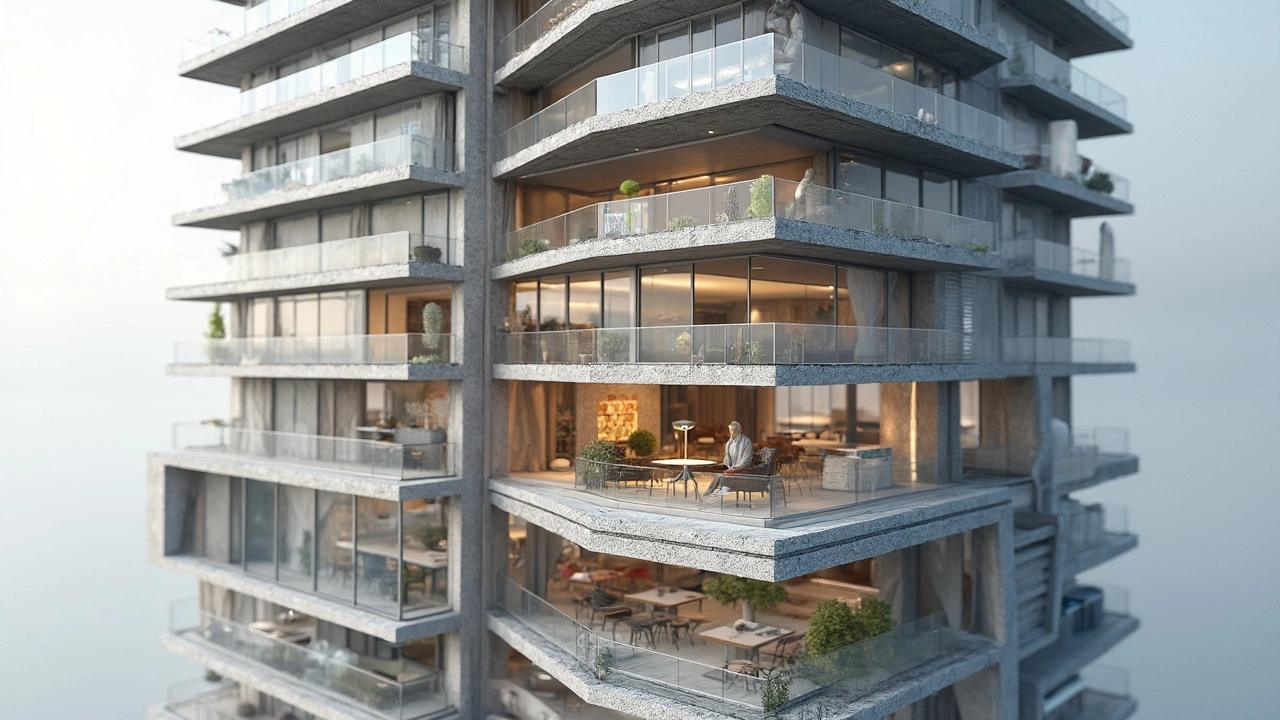Most Popular Home Construction Material: The Reign of Concrete
 Feb, 27 2025
Feb, 27 2025
Ever wondered why concrete is the go-to material for building homes? It's not just about tradition; concrete has some solid perks (pun intended). This mix of cement, water, and aggregates is like the superhero of the construction world—strong, durable, and surprisingly versatile.
But what's the big deal with concrete anyway? First off, it's tough as nails. It can take a beating from the weather and, with a bit of care, last a lifetime. This is a huge plus if you're thinking about building a home that'll stand the test of time.
Concrete's also kind to your wallet. Compared to other materials, it's pretty affordable, especially when you consider the longevity and little maintenance required. But before you jump all in, it's important to see if it's the right fit for your vision and environment.
We'll dig into the details—showing you not just why concrete is a classic choice, but also giving you real-world tips to make the most of this mighty material. Whether you're building a new home or just curious, understanding concrete can make you appreciate the solid foundation it's laid down in modern construction.
- Why Concrete Tops the List
- Strength and Durability Explained
- Concrete's Economic Edge
- Environmental Considerations
- Practical Tips for Homeowners
- Future Trends in Concrete Use
Why Concrete Tops the List
Concrete isn't just any material; it's the backbone of modern home construction. What’s the magic behind its widespread use? Let’s break it down.
Unmatched Strength
When it comes to durability, concrete is king. It can withstand harsh weather conditions, including rain, windstorms, and even earthquakes. This makes it an obvious choice for builders aiming for long-lasting structures. In other words, if you want your home to stand strong generation after generation, concrete is your best bet.
Cost-Effective
Concrete is surprisingly affordable, especially given its durability. This cost-effectiveness extends beyond just initial material costs. Consider the minimal maintenance it requires over the years—no need to constantly repair or replace, saving you both time and money in the long run.
Concrete expert Sarah Harmer notes, "The low life cycle cost of concrete makes it a financially smart choice for homeowners looking to build sustainable homes."
Versatility in Design
You might think that concrete is just for boring, gray slabs, but you’d be wrong. Modern techniques allow it to be molded into various forms and even come in different colors or finishes. Want a polished look that mimics stone or wood? Concrete can do that!
Fire Resistant
One benefit that often goes under the radar is concrete’s fire resistance. Unlike other building materials, it doesn’t combust or spread flames, making homes safer from the risk of fire damage.
Data Snapshot
| Year | Concrete Production (billion metric tons) |
|---|---|
| 2020 | 4.1 |
| 2023 | 4.5 |
| 2025 | Expected 4.8 |
The numbers speak for themselves. With global production ramping up, it’s clear that the demand for concrete keeps growing.
As you can see, concrete has worked its way to the top of the list through a combination of affordability, durability, and versatility. It’s no wonder that so many folks choose it for their dream homes. Ready to see if it suits your needs? Let’s explore its role in depth.
Strength and Durability Explained
When it comes to home construction, the words strength and durability are practically synonymous with concrete. But what exactly makes concrete such a robust material? Well, it's all about its unique composition and the science behind it.
Concrete is incredibly strong because it undergoes a chemical process known as hydration. When water interacts with cement, crystals form and interlock, creating a rock-solid mass. This chemical magic is why your concrete driveway can withstand the weight of your car and why skyscrapers reach new heights.
Why Concrete Stands Out
The strength of concrete isn’t just about brute force. It’s designed to perform under different stressful situations. For example, when reinforced with steel, it becomes not only compressively strong but also able to handle tensile forces. That means it won't crack under pressure, literally!
Now, let’s talk about durability. Concrete structures, when maintained properly, last for decades. Unlike wood, which can decay, concrete resists mold and rot. It's also non-combustible, offering an extra layer of safety compared to other materials. Plus, concrete is pretty weatherproof and can survive extreme conditions, from blazing summers to freezing winters.
The Numbers Behind Concrete
Concrete's strength is measured by its compressive strength, usually ranging from 3,000 to 7,000 pounds per square inch (psi) for residential buildings. To give you some perspective, for industrial structures, this can go up to 10,000 psi or more! Now that's a tough cookie.
Careful Considerations
Despite its toughness, concrete isn’t totally indestructible. It can crack over time due to settling or extreme temperature changes. But with the right mix (proper water-cement ratio) and regular maintenance, these issues can be managed effectively.
Remember, choosing concrete for your home not only gives you peace of mind regarding its longevity but also adds an element of safety and reliability to the structure. It’s no wonder concrete remains a top contender in home construction worldwide.
Concrete's Economic Edge
When it comes to home construction, one of the main factors homeowners and builders alike consider is cost. And here, concrete often steals the spotlight. It's not just about the initial price tag; it's about the overall value and long-term savings.
Initial Costs and Savings
Let's talk about the upfront expenses. Concrete is generally more affordable than materials like steel or wood. The raw materials for concrete are relatively cheap and abundantly available, meaning your initial investment won’t break the bank. Plus, since it's widely used, there's no shortage of suppliers and skilled workers, which keeps labor costs reasonable.
Maintenance and Longevity
Now, you might be asking, 'What about the maintenance?' Here's the kicker: concrete is known for its durability. It requires minimal upkeep compared to other materials. No need to worry about termite damage like you would with wood. This robust nature means fewer repairs over the years.
Energy Efficiency
Did you know concrete can even help save on energy bills? Its thermal mass can absorb and store heat, keeping your home cooler in summer and warmer in winter. This can lead to reduced costs on heating and cooling over time, making it a win-win.
Resale Value
Got plans to sell in the future? Many potential buyers look for homes made with strong, reliable materials. A concrete house usually translates to higher resale value due to its sturdy reputation.
Concrete’s cost-effectiveness comes not just from its price, but from what it saves you over time. All things considered, it's the economical choice for anyone looking to build or invest in a home.

Environmental Considerations
Alright, so concrete is robust and budget-friendly, but how does it stack up environmentally? This part gets a little complicated. Real talk: making concrete means burning a lot of fossil fuels, which bumps up carbon emissions. Not exactly what the eco-warriors are cheering about.
Impact on the Planet
The whole production process—think quarrying limestone, heating it up in kilns—generates a load of CO2, the greenhouse gas we've all been warned about. In fact, if concrete were a country, it'd be the third largest carbon emitter on the planet. That's a pretty staggering thought.
Innovation to the Rescue
But don’t drop your plans just yet. There's some cool innovation happening to make concrete greener. We're talking carbon capture tech, incorporating recycled materials, and even using alternative cements that shrink carbon footprints significantly.
What You Can Do
- Look for eco-friendly concrete mixes the next time you’re talking to builders.
- Consider suppliers that focus on reducing emissions during production.
- Support projects that use recycled materials in their concrete.
| Strategy | Potential CO2 Reduction (%) |
|---|---|
| Recycled Materials in Concrete | 15-20 |
| Alternative Cements | 40 |
| Efficient Manufacturing | 30 |
Being conscious of these issues doesn’t just make you environmentally savvy—it can also come with some cost benefits down the line. So, as you weigh your options, think about both your wallet and the world. Who knew building a home could be such a balancing act, right?
Practical Tips for Homeowners
Thinking about using concrete for your next home project? Here are some handy tips to make the most of this versatile material. Whether you're building new walls or sprucing up the patio, these insights could save time, money, and headaches down the road.
Choose the Right Mix
Concrete is not one-size-fits-all. Depending on what you're building, you'll want a different mix. For instance, a driveway might need a stronger mix than a patio, which demands more flexibility. Always consult with a professional to get the best building materials for your specific job.
Watch the Weather
Weather can be concrete's best friend or worst enemy. Pouring in the rain can weaken the mix, while extreme heat can cause cracks. Aim for mild, dry days if you can. This ensures the weather doesn't mess with the curing process.
Don’t Skimp on Site Prep
Before you pour, make sure the site is ready. That means a clean and level surface. Any debris left behind will only cause trouble later. Proper preparation is critical to the longevity of your home construction.
Seal It for Longevity
Want your concrete to last? Sealing is key. A good sealant protects it from moisture and prevents stains. It's like sunscreen for your concrete—apply it regularly, and you'll keep things looking fresh longer.
Consider Aesthetics
Concrete doesn't have to be just grey and boring. Look into options like stamping and staining to add unique flair to your project. These techniques can add texture and color, transforming plain concrete into something special.
Safety First
Remember, it's not just about getting the job done; it's about doing it safely. Wear proper gear, like gloves and goggles, to protect against splashes or sharp edges.
| Concrete Type | Suggested Use |
|---|---|
| Ready-mix | General home projects |
| High-strength | Foundations, structural elements |
| Lightweight | Insulation, flooring |
Getting hands-on with concrete can be rewarding, giving your home added strength and beauty. Keep these tips in mind, and you'll be well on your way to smart and economical upgrades.
Future Trends in Concrete Use
The future's looking bright for concrete, and it's not just sticking to its old-school ways. As home construction moves forward, concrete is leveling up, getting more sustainable and tech-savvy. So, what's next for this trusty material? Let's break it down.
Going Green
One big trend is making concrete more eco-friendly. This means using recycled materials like fly ash or slag to replace some of the cement. Why? Because making cement isn’t the best friend of the environment. By cutting back on it, the industry can slash carbon emissions.
Smart Technology
Concrete’s going high-tech too. Smart sensors are being embedded into the concrete to monitor its health in real-time. This can predict and prevent problems before they get serious, saving money and hassle down the line.
3D Printing
Believe it or not, 3D printing is another exciting frontier. Imagine printing an entire house directly using concrete! It’s quicker, the designs are endless, and it can reduce waste significantly. This is already catching on in some parts of the world.
Lightening Up
Lightweight concrete might sound like an oxymoron, but it’s making waves—especially in places prone to earthquakes. It’s still sturdy but much lighter, which means buildings can handle shakes better.
As the construction game changes, concrete is keeping up. From cutting down its carbon footprint to getting 3D printed, it remains a central player. We’re likely to see more of these innovations taking root in the coming years, as the demand for building materials that are both affordable and sustainable increases.
